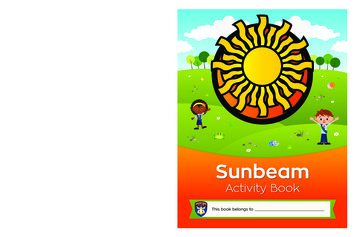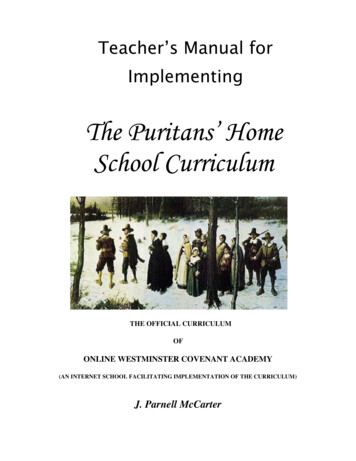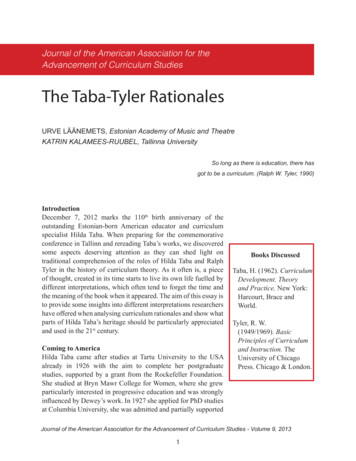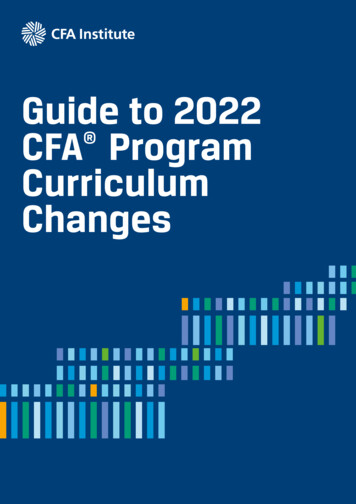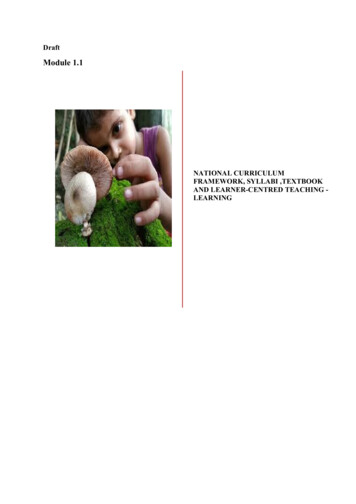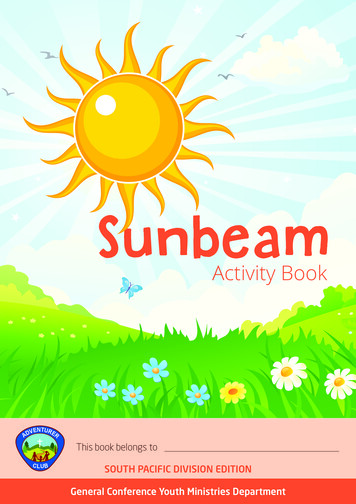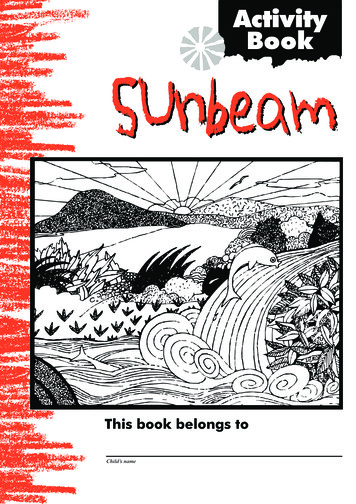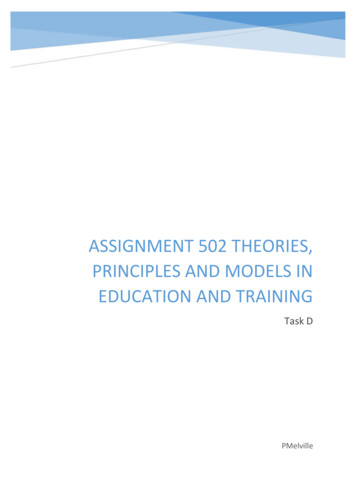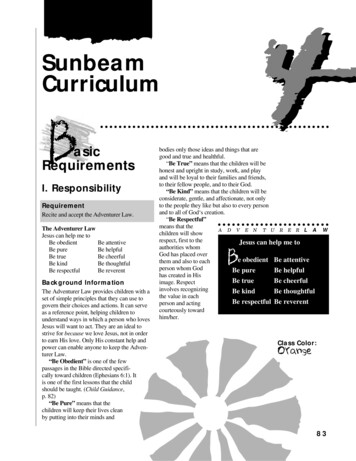
Transcription
4C H A P T E R F O U R S U N B E A M SunbeamCurriculumB asicRequirementsI. ResponsibilityRequirementRecite and accept the Adventurer Law.The Adventurer LawJesus can help me toBe obedientBe pureBe trueBe kindBe respectfulBe attentiveBe helpfulBe cheerfulBe thoughtfulBe reverentBackground InformationThe Adventurer Law provides children with aset of simple principles that they can use togovern their choices and actions. It can serveas a reference point, helping children tounderstand ways in which a person who lovesJesus will want to act. They are an ideal tostrive for because we love Jesus, not in orderto earn His love. Only His constant help andpower can enable anyone to keep the Adventurer Law.“Be Obedient” is one of the fewpassages in the Bible directed specifically toward children (Ephesians 6:1). Itis one of the first lessons that the childshould be taught. (Child Guidance,p. 82)“Be Pure” means that thechildren will keep their lives cleanby putting into their minds andbodies only those ideas and things that aregood and true and healthful.“Be True” means that the children will behonest and upright in study, work, and playand will be loyal to their families and friends,to their fellow people, and to their God.“Be Kind” means that the children will beconsiderate, gentle, and affectionate, not onlyto the people they like but also to every personand to all of God‘s creation.“Be Respectful” means that theA D V E N T U R E R L A Wchildren will showrespect, first to theJesus can help me toauthorities whomGod has placed overe obedient Be attentivethem and also to eachperson whom GodBe pureBe helpfulhas created in HisBe trueBe cheerfulimage. Respectinvolves recognizingBe kindBe thoughtfulthe value in eachBe respectful Be reverentperson and actingcourteously towardhim/her.BClass Color:Orange83
A D V E N T U R E R M A N U A L “Be Attentive” means that the childrenwill pay close attention to what is happeningaround them, especially in reference toobeying God and to the feelings and needs ofothers.“Be Helpful” means that the children willseek opportunities to be of help at home and atschool. True helpfulness is done, not reluctantly, but for the joy of pleasing anotherperson, pleasing Jesus, and making oneself abetter person.“Be Cheerful” means that the children willcultivate the habit of thankfulness for thethings and opportunities that they have ratherthan dwelling on those things that maydisplease them. It means putting a smile onone’s face and in one’s voice in order to makeothers feel happy and thankful as well.“Be Thoughtful” means that the childrenwill choose to think before acting and to basetheir actions upon careful consideration of theconsequences to others and to themselvesrather than simply reacting to feelings andimpulses.“Be Reverent” means that the childrenwill show the highest respect and honor toGod. This includes speaking and walkingquietly in the sanctuary, treating His Biblegently as the best and most important of allbooks, and closing one’s eyes and usingappropriate posture when conversing in prayerwith God.Teaching Tips As you introduce the Law, explain whatit means, why it is important and how itrelates to the Pledge and to the lives ofthe children. Introduce the Law one section at a time,taking a few minutes at the beginning orend of the Adventurer meeting todiscuss and illustrate it. Bible stories andsongs appropriate for each section of theLaw are listed in the Resource List atthe end of the Basic Requirementssection. (Many of the sections of theLaw relate to other Sunbeam requirements and may be introduced orreviewed in conjunction with thoserequirements.) The techniques for memorization ofBible verses, listed in the Appendix, areuseful in helping the children to learnthe Adventurer Law.84 Repeat the Pledge and Law at thebeginning of every Adventurer meeting,along with occasional review anddiscussion of its meaning (in bothplanned and spontaneous ways). Thiswill encourage the children to use theseprinciples in their own daily decisionmaking. Hang the Adventurer Law in a prominent place where the children can referto it at appropriate times during the day.EvaluationThe children will repeat the Adventurer Lawto an adult and indicate a commitment tofollow it.II. ReinforcementRequirementEarn the Sunbeam Reading AwardBackground InformationThe Sunbeam Reading Award is awarded tochildren who read:1. Two chapters from the book of Markfrom a simple modern translation of theBible2. A Bible story or a book about Jesus3. A book on health or safety4. A book on family, friends or feelings5. A book on history or missions6. A book on natureThe Sunbeam reading requirements aredirected specifically toward the topics thechildren will be covering in the Adventurercurriculum.Continued on page 86.
C H A P T E R F O U R S U N B E A M RESOURCEL I S TBasic TrackI. Pledge and Law“Be Obedient”A. Bible Stories and TextsNumbers 20Moses Strikes Rock1 Samuel 15Saul DisobeysJonahJonahEcclesiastes 12:13Acts 5:29B. SongsSing for Joy“Teach Me Lord” . 110“Trust and Obey” . 113“A Happy Home” . 136“Be Pure”A. Bible Stories and TextsPhilippians 4:8Psalm 24:3,4Matthew 5:8B. SongsSing for Joy“Dare to Be a Daniel” . 116“Be True”A. Bible Stories and TextsGenesis 27Jacob and EsauActs 5Ananias LiesEphesians 4:25B. SongsSing for Joy“I would Be True” . 1172. Kids Sing Praise“Truth” . 35“Be Kind”A. Bible Stories and TextsEphesians 4:32Matthew 5:44Romans 12:10B. SongsSing for Joy“A Happy Home” . 136“Be Respectful”A. Bible Stories and Texts1 Sam. 17-31David and Saul2 Kings 2Elisha and Bears“Be Attentive”A. Bible Stories and Texts1 Sam. 2God Calls SamuelMatthew 25Ten VirginsMatt. 26:36-46Gethsemane (Matthew 26:36-46)“Be Helpful”A. Bible Stories and TextsGenesis 18Abraham and Angels1 Samuel 25AbigailLuke 10:25Good SamaritanB. SongsSing for Joy“Cross Over the Road” . 131“Be Cheerful”A. Bible Stories and TextsExodus 13Israelites Grumble2 Corinthians 9:7B. Songs1. Sing for Joy“Smile” . 1072. Kids Sing Praise“Grumblers” . 47“I’ll Be a Sunbeam” . 52“Be Thoughtful”A. Bible Stories and TextsMark 12:42Widow’s MiteB. SongsSing for Joy“Love at Home” . 137“God Bless Families” . 138“Be Reverent”A. Bible Stories and TextsIsaiah 6Isaiah’s Vision’sLuke 6:7Building TempleJohn 2:13MoneychangersB. SongsSing for Joy“God Is in This Place” . 46“I was Glad” . 144“This Is God’s House” . 14585
A D V E N T U R E R M A N U A L Teaching Tips A parent, teacher, leader, older Adventurer, Pathfinder, or grandparent mayread to the Sunbeam if necessary. Reading lists may be distributed at thebeginning of the summer so books maybe completed over the summer months. Many good storybooks are available thatdeal with the topics listed above in atruthful and sympathetic way. Read anynew book carefully to determinewhether it is appropriate for the Sunbeam age group and upholds Christianbeliefs and standards. (More detailedcriteria are provided in Appendix.)86 A simple reading motivator can be madeby adding a new link to a reading chaineach time a book is completed. Photocopy links on colored paper with spacefor the name of the book, the topic andthe child’s name. Join the links to eachother in the manner of a real chain, orcut them in a special shape (such assmiley faces, etc., to fit a theme) andpost on a wall to stretch around theroom. (See Appendix for examples.)EvaluationThe children will turn in lists, signed by anadult, giving the name and topic of each bookread.
C H A P T E R F O U R S U N B E A M My GodI. His Plan to Save MeRequirementA. Create a story chart or booklet showingJesus’: Birth Life Death ResurrectionOR the Bible stories you are studying inyour classroom or Sabbath School.B. Use your story chart or booklet to showsomeone the joy of being saved byJesus.Background InformationThe Sunbeam requirement builds upon theBusy Bee emphasis on Jesus’ love and carefor them and His plan to save them from evil.The basic concepts emphasized in thisrequirement are the ugliness of sin and eviland our need of Jesus’ forgiveness for, andhelp in overcoming sin.The coming of Jesus to earth is one of themost amazing events in the history of theuniverse. The Son of God came as a humanbeing and suffered from the awful effects ofsin in order to save the very sinners whodestroyed His world by disobeying Him. Hechose to be born as a human child to a poorfamily to show us what God is like and whateach one of our lives can be like if we followHim. He acted in love toward people byfeeding or healing them and by telling themthe exciting news of His wonderful plan torescue us from sin and make us a part of Hisown kingdom.During His life on earth He demonstratedHis love and forgiveness in many ways. Hehelped Mary Magdalene to understand Hislove and forgiveness and helped her choose tolive as a good and happy person. The paralyticmade himself sick from the bad things he haddone, but Jesus told him that his sins wereforgiven. Jesus gave him the strength to get upand to live a good life. Jesus told the story ofthe prodigal son to teach His followers thateven though we may do many foolish things,He is always waiting and eager to forgive usand help us to live more happily.The horribleness of sin is shown by thewillingness of the people to hurt and kill Jesus,the Son of God, in order to get what theywanted for themselves. His death on the crossgave Him the right to forgive us and showedhow much He really loves us. When He roseagain He showed His power over death andthe life He will bring to all who love Himwhen He comes again. (Stories from theclassroom or Sabbath School Bible curriculummay be chosen to emphasize these sameconcepts, if you prefer.)Teaching Tips Check the description of how to assemble the Bible story chart at the endof the teaching tips. (A similar chart,relating to the stories covered in theclassroom or Sabbath School, may bemade by following the same basicinstructions and inserting pictures fromother sources.) The story chart may be used in threedifferent ways:1. The leader may put the chart up ona wall, adding each new picture ashe or she tells the story. Thechildren may refer to this chart asthey work on their own chart(s)and as they learn about otherstories from the Bible and fromhistory.2. Children may also color thepictures and use the stories andlabels to create their own storycharts or story chart booklets.87
A D V E N T U R E R M A N U A L Present the Bible story chart as anopening activity to help the childrenunderstand Jesus’ life as the center ofthe plan of salvation. Review the majorevents of earth’s history introduced atthe Busy Bee level: creation, sin andsadness begin, Jesus cares for me today,Jesus comes again, and heaven. (Thepictures and labels describing theseevents may be placed on the story chartin black and white.) Color the newSunbeam pictures and add them to thestory chart as you tell about the life ofJesus. Stories giving the life of Jesus in moredetail may be presented to the childrenas a series of worship talks. (This couldeasily fit in with the SDA Biblecurriculum during those years that dealwith the life of Jesus.) The stories ofMary Magdalene, the paralytic and theprodigal son are especially useful inhelping children understand the resultsof sin and the forgiveness and salvationavailable through Christ.88 Make the stories real by learning moreabout the world Jesus lived in. Childrencould follow Jesus’ journeys on a map,build models of typical homes orvillages of Jesus’ day, or try some of thefoods or daily activities of the time.Reinforce their understanding by havingone child or team name a place on themap of Jesus’ world and having asecond player or team attempt to find itwithin 30 seconds. A mural showing a story of Jesus can bemade in a small way as a comic strip orseries of scenes to wind through a cerealbox “television” or be painted or coloredon a long sheet of paper that could beput up in a hallway. The children may share their story chartsor booklets with another individual orbefore a group during a club or classroom worship or Sabbath School specialfeature.EvaluationThe children will place the pictures and labelscorrectly on the Bible story chart. They willdiscuss their experiences of using their chart toshare the joy of Jesus’ salvation with others.
C H A P T E R F O U R S U N B E A M STEPBYSTEPMaking a Bible Story ChartThe Bible Story Chart will help children understand Biblehistory by experiencing it visually and actively. A simplemethod for making a basic story chart is describedbelow. It is designed for use within the smaller picturesand labels provided. The measurements may need to belarger if you desire to use larger pictures.Materials Eight sheets of 9" x 12" purple construction paper Two sheets of 9" x 12" yellow construction paper Rubber cement or craft glue Pictures provided on the following pages or collected to illustrate the stories studied in the classroom or Sabbath School Clear contact paper or laminating filmDirections1. Glue the purple paper together end to end to make along, narrow length of paper, as illustrated on thefollowing page. The six sheets represent the 6,000years of Biblical history. The dark color representsthe earth suffering from evil and sin.2. Next, glue one sheet of yellow paper to each end ofthe purple paper. Yellow represents the time of joyand happiness before sin entered, and the timewhen Jesus comes again to destroy sin and take usto heaven. Cut the yellow sheets in a wavy line.This shows that time continues forever in bothdirections.3. Copy the smaller pictures, labels and storiesprovided. Color them, cut them out, and mountthem on heavier paper.4. The chart may now be hung on the wall or used inpresenting or practicing the story. The story chartand its parts may be laminated or covered withclear contact paper to allow children to manipulateit freely without fear of damage.5. The children may create their own smaller charts inthis way. They may use smaller dimensions. Thediagram on the next page shows how the stories foreach year fit together on the story chart to make awhole.6. Large pictures are located in the appendix section atthe end of the manual.Four Year Composite Wall ChartBusy BeeSunbeamBuilderHelping Hand89
90Jesus’ LifeJesus showed people how much Heloves them. He showed how happywe can be if we obey Him.Jesus’ BirthJesus, God’s Son, came to earth asa baby to help people.A D V E N T U R E R M A N U A L
Jesus’ ResurrectionJesus came back to life after threedays. He is in heaven, now, watchingover us.Jesus’ DeathJesus let evil men kill Him on a crossbecause He wanted to take awayour sins.C H A P T E R F O U R S U N B E A M 91
A D V E N T U R E R M A N U A L II. His Message to MeRequirementA. Memorize and explain two Bible versesabout being saved by Jesus. Matthew 22:37-391 John 1:9Isaiah 1:18Romans 6:23Your choiceB. Name the two major parts of the Bibleand the four gospels.Background InformationThe memory texts have been chosen toemphasize the key Sunbeam concepts of themeaning and results of sin and the sacrifice ofJesus to forgive us and to rescue us from sin.Other verses which teach these concepts mayalso be used.The second grade child is ready to understand the chapter and verse division in theBible and to begin learning to use the Table ofContents to find Bible books. They shouldbe encouraged and assisted infinding their own verses wheneverpossible.The Sunbeam Bible story chart isbased on the life of Jesus told in theGospels. Children should know thenames of these four books andbecome familiar with them as theywork with the stories.They will find it easier to getaround in the Bible once they know itstwo major parts, the Old and NewTestaments, and recognize that the OldTestament refers to things that happenedbefore Jesus came and the New Testamentrefers to what happened during and afterJesus’ life on earth. Reinforce this understanding by showing the place of the Oldand New Testament on the Bible storychart.92Teaching Tips The memory verses may be chosen bythe child with the help of the leader orby the leader alone. Choose verses thatwill be most helpful to the child at thispoint in his/her experience with Jesus.The foremost goal in learning thememory verse is for the child to understand its meaning and its application tohis/her life. A wide variety of techniques forteaching the memory verses are explained in the “My God” section of theAppendix. Refer to the gospels and Testamentsfrequently while working with the Biblestory chart. In this way memorization ofthese two books will be a fast andsimple process of review.EvaluationThe children will repeat and explain the Bibleverses and name the books.
C H A P T E R F O U R S U N B E A M RESOURCEL I S TMy God TrackI. His Plan to Save MeA. Other Bible Stories About SalvationGenesis 6-8NoahMatt. 9:1-8Paralytic HealedJohn 3:19-21Parable of LightB. Songs About the Assigned Stories1. Sing for JoyJesus’ death and resurrection:“God Is So Good” . 13“John 3:16” . 24“For God So Loved the World” . 26“O, How He Loves You and Me” . 28“He’s Alive” . 84“This Is the Day” . 86“He Is Lord” . 87C. Books And Materials About the Assigned Stories1. AdultBible Teaching picture. Several sets on the life ofChrist (Standard)Giant Bible Visuals: Jesus (Rainbow)White, E. G., Desire of Ages2. ChildrenStorytime Adventures in the Life of Christ. Cassettesand puzzle book (Voice of Prophecy)Maxwell, Arthur S., Jesus, Friend of ChildrenReece, Colleen, Julie’s Three Special LettersJesus Coloring Book, The Life of Jesus (Standard)II. His Message to MeA. Other Bible Texts About SalvationPsalm 32:5“I acknowledged my sin unto Thee.”1 John 3:4, 5“Sin is the transgression of the law.”Isaiah 44:22“I have blotted out thytransgressions.”John 14:1-3“I go to prepare a place for you.”Romans 34:23“All have sinned.”Galatians 1:3, 4 “[He] gave Himself for our sins.”James 4:17“To him that knoweth to do good ”B. Songs About Salvation1. Sing for Joy (Review and Herald PublishingAssociation)“His Banner Over Me Is Love” . 25“I’m So Happy” . 65“Redeemed” . 68“Amigos do Cristo” . 692. Kids Sing Praise (Brentwood)“Assurance March” . 13“Thank You, Lord” . 30“We’ll Call Him Jesus” . 55C. Ellen G. White Quotes“If properly instructed, very young children mayhave correct views of their state as sinners andof the way of salvation through Christ.” Vol. 2,Testimonies, p. 396“Teach them that the Savior is calling them.”Desire of Ages, p. 517.“They will learn to hate sin and to shun it, notmerely for hope of reward or from fear ofpunishment, but from a sense of its inherentbaseness—because it is degrading to their Godgiven powers ” Counsel to Parents, Teachers,and Students, p. 21“God wants every child of tender age to be Hischild, to be adopted into His family .Thewhole current of their thought may be changed,so that sin will not appear a thing to be enjoyed,but to be shunned and hated.” Child Guidance,p. 486D. Books and Materials About Salvation1. ChildrenGod’s Perfect Measuring Stick —flannelgraphstory on Ten Commandments and need forsalvation (Standard)III. His Power in My LifeA. Bible Stories and Texts2 Kings 22, 23Scriptures FoundActs 17:10-13BereansDeut. 6:4-9“These words shall bein thine heart ”Psalm 119:9-11, 105 “Thy work is a lamp unto myfeet ”Psalm 19:7-11“The law of the Lord is perfect ”2 Timothy 2:15 “Study to shew thyself approved ”B. Songs1. Sing for Joy“The Bible, God, Is Wise And True” . 19“I Am So Glad” . 30“Saints of God” . 612. Kids Sing Praise“The B-I-B-L-E” . 16“Thy Word Have I Hid in My Heart” . 67“Wonderful Words of Life” . 71Continued on next page.93
A D V E N T U R E R M A N U A L III. His Powerin My LifeRequirementA. Spend a regular quite time with Jesus totalk with Him and learn about Him.B. Ask three people why they study theBible.Background InformationIf a child learns at an early age to set asidedaily time for private devotions, and if he/sheis helped to make this a habit, it will be easierto avoid that long uphill battle that mostChristians face in making a habit of “finding”time for God.Because families have widely differingschedules and levels of commitment, andbecause children have differing levels ofability and interest, the requirement leaves thefrequency, length, and format of these “quiettimes” open. These factors can be decidedupon by the child in consultation with aparent, or leader, ranging from the ideal ofdaily morning and evening devotions, to aminimum of weekly Sabbath School, or clubworship for those who are unable to participate in any other way. In the beginning, aparent or other adult will need to spend thequiet time with the child, teaching him/herhow to enjoy spending time with Jesus.There are many different ways in whichchildren learn more about Jesus. By listeningto other Christians talk about their experiences RESOURCEL I S TMy God Track (continued)C. Ellen G. White Quotes“That spirit loves to address the children and discover tothem the treasures and beauties of the word. The promisesspoken by the Great Teacher will captivate the sense andanimate the soul of the child with a spiritual power that isdivine.” Counsels to Parents, Teachers, and Students, p.172“The best way to prevent the growth of evil is to preoccupythe soil. The greatest care and watchfulness is needed incultivating the mind and sowing therein the preciousseeds of Bible truth.” Messages to Young People, p. 282“We should make the Bible our study above every otherbook.” Ibid, p. 426.“In arousing and strengthening a love for Bible study, muchdepends on the use of the hour of worship.” Education, p.186.“In its wide range of styles and subjects, the Bible hassomething to interest every mind and appeal to everyheart.” Child Guidance, p. 505.D. Books and Materials1. AdultsWhite, E. G., Education, pp. 85-194.Ibid., Messages to Young People, pp. 253-264.Ibid., Child Guidance, pp. 41-44, 505-515.94
C H A P T E R F O U R S U N B E A M with Bible study, the children can see that it isan important thing to real people and becomeaware of some of the ways in which they canapproach Bible study.Teaching Tips Present the importance of privatedevotions after the child has becomeacquainted with Jesus’ love and plan forhim/her.Establishing a habit of spending timewith Jesus as a friend requires dedicatedguidance and supervision from bothparents and leaders. Ideas for teaching parents about quiettime for children are provided in the“My God” section of the Appendix,along with several suggestions forplanning family worships. The Adventurer leader can encourageprivate devotions by:a. sharing some of his/her ownexperiences with private devotions;b. talking of the benefits of a regularquiet time;c. providing frequent occasions forchildren to discuss their experiences;d. frequently discussing times, placesand methods for enjoying the quiettime;e. making available a wide variety ofdevotional reading;f. helping and encouraging parentsto assist their child in regularprivate (and family) devotions. The children or the leader may inviteseveral adults to come in and talk abouttheir experiences with Bible study. Keepit short (5-10 minutes). Afterwards,discuss the speaker’s ideas. The childrencan make a chart showing what theylearn from each person,OREach child may write his/her question(s)on a card and present them to the adultsof his/her choice.EvaluationThe children will present and discuss theirquiet time commitment cards and talk aboutwhat they have learned about Bible study.95
A D V E N T U R E R M A N U A L My SelfI. I Am SpecialRequirementMake a tracing of yourself. Decorate it withpictures and words which tell good thingsabout yourself.Background InformationThis activity is designed to help children thinkabout themselves as individuals, and torecognize some of the similarities and differences they share with other people. Youngchildren tend to focus on external similaritiesand differences but also enjoy talking aboutfavorite likes and dislikes.Some of the similarities that children mayfind as they work on their tracings include thefact that we all: 1) have bodies, with similarneeds and abilities; 2) have feelings, needs,and desires; 3) make wrong choices andmistakes sometimes; and 4) are specialbecause God made us and loves each of us.The children will recognize many differences in size, skin, hair, and eye color, generalinterests, and special abilities. Differences andhandicaps can be recognized as things thathelp each of us to be special (not as bad orscary things). The similarities we share makeeach of us a part of the greathuman family who canappreciate each other’sdifferences and carefor each other becausewe are all importantto God.96Teaching Tips The tracings can be made in two ways:1. If there is sufficient paper andspace, have each child lie on alarge sheet of butcher paper whileanother child traces around hisbody with a water-color markingpen.2. Tracings may also be done byusing a strong light to project aprofile of each child onto a pieceof paper that has been taped to thewall. Another child can tracearound the shadow with a pencil. Next, have each child describehimself\herself using some of thefollowing ideas. This may be donetogether at the teacher’s direction, orvarious ideas may be written on cardsfor the children to work with individually. Drawings, cut-out pictures orwritten words and phrases may be used.1. Child’s name, its meaning, howparents chose it2. Physical Characteristicseye/hair colorlength of foot, hand, armfingerprint, footprintclothingageheightweightbirthday (earliest memory )home addressphone numberheart rate (sitting, running)3. Likes and Dislikesfoodcoloranimalthings to do (alone, withfriends or family)game or sportbooktree or flowermonth or daynumberweatherholidayheroBible versepeopleBible character
C H A P T E R F O U R S U N B E A M placesongsubjectthings to make4. FeelingsI feel xcitedrejectedafraidimportant5. Special Abilitiesbest/nicest thing I ever didthings I’m good atI feel good about me because 6. Ideas and Dreamsday dreamsthree wisheswhen I grow up I will be I believe in someday I hope something I want to change aboutmyself is in 5-25 years I want to Emphasize the importance of “internal”characteristics by first putting onlyphysical things on the tracings. Askwhether the children can tell, from thosethings, whether a person would make agood friend or neighbor.(See 1 Samuel 16:7). Display the tracings for children todiscuss and enjoy. A picture of Christand a heading such as “Jesus Made UsSpecial” may be hung above them. Take time to discuss similarities anddifferences with the children to helpthem learn to accept and appreciate eachother for their uniqueness. Discuss anyprejudices or stereotypes the childrenmight face, and help them deal withthem.EvaluationThe child will complete a body tracing.II. I Can Make WiseChoicesRequirementPlay the “What-if?” game.Background InformationThe choices we make daily are based uponthose things that we consider to be trulyvaluable. These values strongly influence ourfeelings and thoughts. They influence ourdecisions even though we may be unaware ofit. Often people claim to value something veryhighly but their actions show that there is adifference between what they claim to valueand what they actually value. One examplewould be the mother who tells her child that
Two chapters from the book of Mark from a simple modern translation of the Bible 2. A Bible story or a book about Jesus 3. A book on health or safety 4. A book on family, friends or feelings 5. A book on history or missions 6. A book on nature The Sunbeam reading req
